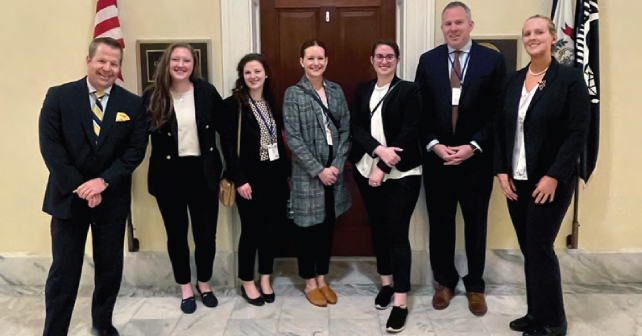
Catherine “Kirby” Kirbos, MD, is a fellow at West Virginia University who works at several different emergency department (ED) sites, from the state’s Level I trauma center to rural, critical access sites. When she works overnights at Braxton County Memorial Hospital in Gassaway, West Virginia, her three-woman team (herself and two nurses) receives patients from six small towns nearby. “Small but mighty,” is how Dr. Kirbos describes it.
Explore This Issue
ACEP Now: Vol 42 – No 06 – June 2023As a member of the West Virginia delegation at ACEP’s Leadership & Advocacy Conference (LAC) in May 2023, Dr. Kirbos got a chance to explain her day-to-day challenges to her state’s legislators, including Sen. Joe Manchin. LAC is all about taking the national issues that every emergency physician at the conference is lobbying for—in this case, ED boarding and workplace violence—and making it come to life for legislators by explaining how it is happening in their own backyard.
What is happening in West Virginia’s backyard? Quite a bit, actually. In January 2023, Forbes ranked West Virginia as the least healthy state in the country.1 The state tops the country in overdose deaths per population.2 West Virginia has the highest percentage of adults who smoke and the second-highest obesity rate in the country. The state’s high poverty rate and challenging terrain cause many to defer basic health care, leading West Virginia to rank the highest of all states in mortality rates for cancer, diabetes, heart disease, and kidney disease.2
“Here in West Virginia, we try to take a rural perspective on everything,” said Chris Goode, MD, FACEP, who was making his 10th trip to LAC. “When you’re working with your local Congressmen, Congresswomen, Senators, it is really important to put that statewide perspective on these very national issues.”

Meet the West Virginia contingent at LAC23: Catherine Kirbos, MD; Adam Crawford, DO; Kaitlyn Meads, DO; Hannah Marvin, DO; Carol Wright Becker, MD; Christopher Goode, MD; Darcy Autry, MD. (Click to enlarge.)
Many of these health problems and access-to-care concerns come to a head in West Virginia’s emergency departments, both big and small. Like many emergency departments across the nation, the state’s larger EDs are overcrowded. When those facilities have no room to accept transfers, that puts the emergency physicians at the smaller rural facilities, like Dr. Kirbos at Braxton Memorial, in a tough spot.
“We are managing extremely sick patients in small critical access hospitals to the best of our ability, waiting for transfer elsewhere,” she explained. “Even worse, when we do finally get a patient accepted at the larger facility for transfer, we often don’t have an ambulance or EMS crew to transport them because we are stretched so thin.”
Pages: 1 2 3 | Single Page





No Responses to “West Virginia EPs Explain Challenges of Rural EM to Their Legislators”